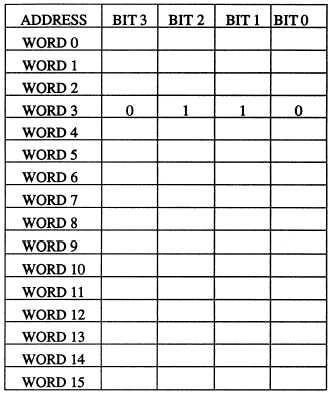word, it would take two 4K by 16 chips to provide 4,096
addresses of 32 bits each.
To illustrate the random access nature of RAM, the
number of words or addresses, and bits per word, we
offer a simple illustration. Figure 6-26 shows the
organization of a 64-bit memory. The 64 squares
(mostly blank) in the figure represent the 64 positions
that can be filled with data. Notice that the 64 bits are
organized into 16 groups called words. Each word
contains four bits of information. This memory is said
to be organized as a 16 × 4 memory. That is, it contains
16 words, and each word is 4 bits long. The total
number and capabilities (16 by 4 and so forth) of these
individual circuits will define the total memory
capacities of the respective computer.
In our example, the total number of memory cells
is 64. There are many variations in the ways a 64-bit
memory could be organized: 64 × 1, 32 × 2, or 8 × 8.
The memory in figure 6-26 looks very much like a truth
table on a scratch pad. On the table afterword 3, you’ll
notice the contents of word 3 is (0110). We say we have
stored, or written, a word into the memory; this is the
write operation. To look-at the contents of word 3, we
simply read the contents of word 3 using the read
operation. What is also important about RAM memory
is that we can read or write into any word on the table
and in any order, that is why it is called random access.
Figure 6-26.—Organization of a 64-bit memory.
Static RAM (SRAM)
Static random access memories (SRAMs) are
semiconductor integrated circuits that use a flip-flop
application for each storage cell. Figure 6-27 illustrates
Figure 6-27.—SRAM cell and associated circuitry.
6-22


